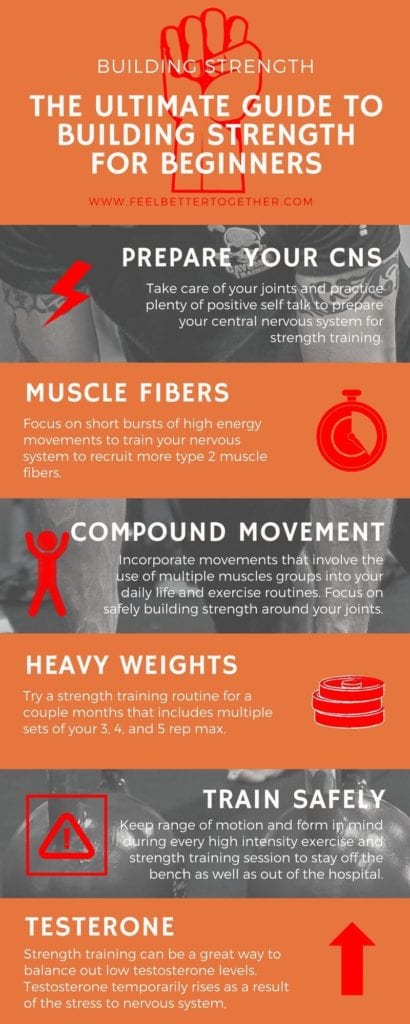In this topic, we’ll talk about how you’ll feel much better after building up your body’s physical strength. Or is it that you are trying to build up particular muscles?
Athletes usually aren’t interested in massive muscles. They focus on building flexibility, physical strength, and endurance.
High levels of physical strength help them compete at professional levels.
Five Key Points to Building Strength for Beginners
- Take care of your joints and practice plenty of positive self-talk to prepare your nervous system for strength training.
- Focus on short bursts of high energy movements. Train your nervous system to recruit more type 2 muscle fibers.
- Incorporate movements that involve the use of many muscles. Focus on safety and building joint strength while doing compound exercises.
- Try a strength training routine that includes up to six sets each workout of your three to eight rep max.
- Keep your range of motion and form in mind during every high-intensity exercise. Stay off the bench as well as out of the hospital.
BONUS TIP! Include high-intensity strength-building movements into your daily routine. A couple of these are climbing and hammering movements like chopping wood.

The Nervous System – Where Do Muscles Get Strength?
Your nervous system handles detecting and coordinating physical movements. It evaluates the difficulty and safety of any action. After doing its evaluation, it sends electrical signals to your muscles, which then contract and move to meet the strength requirements of the movement.

Your nervous system handles detecting and coordinating physical movements. It evaluates the difficulty and safety of any action. After doing its evaluation, it sends electrical signals to your muscles, which then contract and move to meet the strength requirements of the movement.
There are several things your nervous system considers. The primary question that it asks when you perform physical movements is “can I complete this action without injury?”
Can I perform this movement without injury?
Your nervous system is capable of sending too much electrical current, and so much that it rips the fibers off the bone. Your joints are also a significant factor when it comes to how safe a movement is.
Neck, wrist, knee, ankle, and especially spine stability are essential. If any of these are weak or injured, you will need to start small before you can see significant strength gains.
Your brain does not want to overload a part of your body that is already struggling. Your nervous system knows when something has the risk of injury.
Is it possible to perform this movement?
The strength formula is partly physical and partly mental. Prior conditioning and attitude come into play here. If you’ve been performing a task for a long time, the pathways to accomplish that task are already built up. Your brain knows that you can do this, you believe you can.
If you are a real beginner to building strength, you’ll need to uncover confidence and motivation. You need to believe in yourself to exceed your current strength levels.
If you tell yourself you can’t do it, that you’re not that strong, your brain thinks it’s true. Your nervous system will downgrade energy output to keep you safe. You will only ever be as strong as you believe you are.
You can train your nervous system to work well with your muscles to develop strength. Over time you can build up your joint strength to reinforce stability. Then you can perform safe and intricate movements to condition your nervous system.
You’re on your way to high levels of physical strength. As long as you train on a consistent basis, you’ll get there. Or else your nervous system will start to lose those built-up pathways that lead to higher energy output.
Types of Muscular Contraction – How Muscles Use Energy
We already know that your nervous system sends electrical impulses to your muscles. These impulses travel all the way into the cells of that muscle.

Your muscle fibers contain what doctors call myocytes. In muscle tissue is a combination of type 1 and type 2 myocytes. Let’s learn more about how each performs when it comes to physical strength.
Slow Twitch Muscle Fibers
Type 1 myocytes are dominant in slow-twitch muscle fibers. They have low activity levels because of the process they use to use and restore energy. Although slower, type 1 myocytes are still powerful because they have energy stores too.
However, type 1 myocytes take a long time to fatigue because they are resistant to using up all their energy at once. People with sedentary lifestyles have an estimated 55% type 1 muscle fibers.
Fast Twitch Muscle Fibers
Fast-twitch muscle fibers contain an increased number of type 2 myocytes. We know these to be much quicker when receiving signals from your nervous system. They are more conductive and can contract at more than twice the rate of slow-twitch muscle fibers.
There are two different types of fast-twitch muscle fibers, which are ones with more type 2A myocytes and those with more type 2X myocytes. Your nervous system recruits them at different times. Which one it decides to enlist depends on the intensity and duration of your workout.
Type 2A myocytes are perfect for training with moderate to high amounts of force over time. The muscle fiber is more conductive than with type 1 myocytes, which increases power. Type 2A myocytes have some resistance to becoming quickly fatigued.
Type 2X muscle fibers fire faster and almost non stop. They are perfect for short-term very high energy training. Type 2X myocytes contract and release quicker than the other myocyte types. These are the muscles that the strength enthusiasts use when they lift cars and pull semi-trucks.
You can build up pathways in your nervous system that recruit more type 2 muscle fibers. Perform high-intensity exercises. Doing this will give you a considerable boost in physical strength, and is necessary to make strength gains later on.
Compound Movements – Building Core Strength
When it comes to physical strength, the more muscle fibers that you recruit, the better. Every movement that your body performs requires the use of at least one joint and muscle group. Compound movements cause your nervous system to recruit more joints and muscle fibers.

Compound movements connect parts of your nervous system that govern various body parts. When you use multiple parts of your body at once, pathways are built up, resulting in quicker contraction.
Many muscle groups contributing to a physical movement means more energy output and thus more physical strength.
You need to train your nervous system to do this. Your body’s natural inclination is to preserve energy, not use as much as possible.
Stability is a concern because compound movements use various joints and muscle fibers. For people with joint problems, this is an even more significant concern. You can turn all compound movements into joint building movements. Do this by focusing on the safe use of your joints while doing compound movements.
You can do this to strengthen the connecting muscle fibers between joints, which increases stability. Focus on grip and posture any time you think of performing an incredible feat of strength.
You don’t need to go to a gym to do this. Let’s take a look at some strength-building compound movements that you can do almost anywhere.
Everyday Strength Building Compound Movements
- Hanging exercises like pull-ups
- Climbing, especially rock climbing
- Variations of planks that use more of a spread stance
- Heavy hammering motions like chopping wood
It should be pretty easy to include these movements in an active lifestyle. A beginner should focus on these moves as a first step. You need to prepare your nervous system and joints for the heavy lifting. For safety’s sake, you need this preparation to reach high levels of physical strength.
Weightlifting for Strength – High Weight, Low Reps
The average muscle endurance program calls for about 12-20 reps in each set. Your goal is to lift a heavy enough weight to fatigue your muscles in more than 12 but less than 20 reps.
But, strength building requires that you fatigue your muscles in a set of between 3-8 reps. If you are beginning your strength training program, you’ll need to first train for stability and muscle endurance, and you’ll also need to know what’s called your one-rep max (1RM). Your one-rep max is the most weight that you can lift while doing one complete rep.

Each exercise uses different muscle groups, capable of varying levels of strength, so your one-rep max is likely different for each activity you perform.
Trying to lift this much weight is very dangerous, so let’s take a closer look at how to safely find your one rep max.
Calculating your one-rep max is possible. You can plug in your 4, 5, or 6 rep max and then use percentages. The safest way to find your one-rep max for an exercise is to use a rep max calculator.
Now that you have your one-rep max it’s time to put that information to good use. 3-8 reps in each set are what we are going for here. Like we said before there are percentages that you can use to find out what your three, four, and five rep max is. Your three rep max is roughly 93% of your one-rep max weight, and your five rep max weight is approximately 87%.
An effective strength training program requires what trainers call a weight table. This table has all your rep maxes for a given exercise. Using it gives you quick numbers when you need to know how much weight you should be lifting.
These programs usually go something like this: Sets at 87% of your one-rep max, followed by many sets at 90%, then many sets at 93%. The most massive weight that you should be lifting, to avoid injury at least, is 93-95% of your one-rep max.
This training style becomes necessary after lifting weights for a few months. Your muscles and nervous system have adapted to the amount of weight you’ve been using. Lifting heavier weight puts the right kind of stress on your muscle fibers and nervous system.
Preventing Training Injuries – Stay Off the Sidelines
Anyone who does intense exercise or lifts has experienced various levels of pain. Some pain isn’t that bad, like the two-day soreness that comes after isolating a muscle.

But, some of us have experienced week-long pain. The worse is when an injury requires months of rehab before going back to your routine. Let’s take a look at how you can prevent these types of injuries.
Get a Good Warm-up
It is a good idea to get your blood pumping before any challenging physical movement. Higher body temperature helps muscles to loosen and contract.
Forgetting to warm up before intense exercise causes muscle tears because of the stiffness of cold muscles. Warming up can consist of a run or as little as a few minutes of proper stretching.
Always Use Good Form
Let’s think about exercise form for a second. While you’re using proper technique, the exercise you’re doing uses the intended muscles, but when you’re doing it wrong, you’re not using the intended muscles for that activity.
If you’re not using the expected muscles, you’re using muscles connecting other joints.
Continuing to exercise this way puts loads of stress on your joints. The reason for such improper form can be that you didn’t learn it before doing the exercise.
Or it could be that you continue to exercise after you’re already exhausted, and your form suffers. Regardless of the reason, lifting the wrong way can cause serious injury as well as back pain down the road.
Avoid Dangerous Movements
‘Range of motion’ is a fundamental principle here, and is a term that refers to how much a muscle can stretch without causing injury.
It may be hard to picture, but some muscle fibers are connecting our bones to one another. Overextending these muscles also causes muscle tears and severe joint pain.
A typical example of this is when new weightlifters try Olympic style weightlifting. This type if lifting works the entire muscle through an extended range of motion. Lousy form while doing this kind of training takes you outside of your range of motion.
When doing any exercise or weightlifting keep in mind how far your muscles are extending. Inside your range of motion is where you want to be.
Doing intense exercises and heavy weightlifting is all fun and games until you get hurt. Now that you know how to avoid the most common injuries, the fun and games can continue.
Safety should be your first concern when hitting the gym or pushing your body to the next level. Nothing kills your gains quite like getting hurt.
In Conclusion
We all want to feel right about how well we can carry out physical tasks, even the challenging ones. You now have the information you need to build physical strength. It’s time to focus on your attitude and strength goals.
What will you achieve and how will you feel about all your new strength? You will need some inner drive to push past your objections. Imagine yourself strong enough to take on things you once thought impossible.
Believe in yourself and incredible strength gains are possible for you. With persistence and attention, you’ll get there. You can perform difficult movements and reach higher levels of physical strength.


Waiting patiently for you to come home and fuck me! https://bit.ly/3UKFVxa